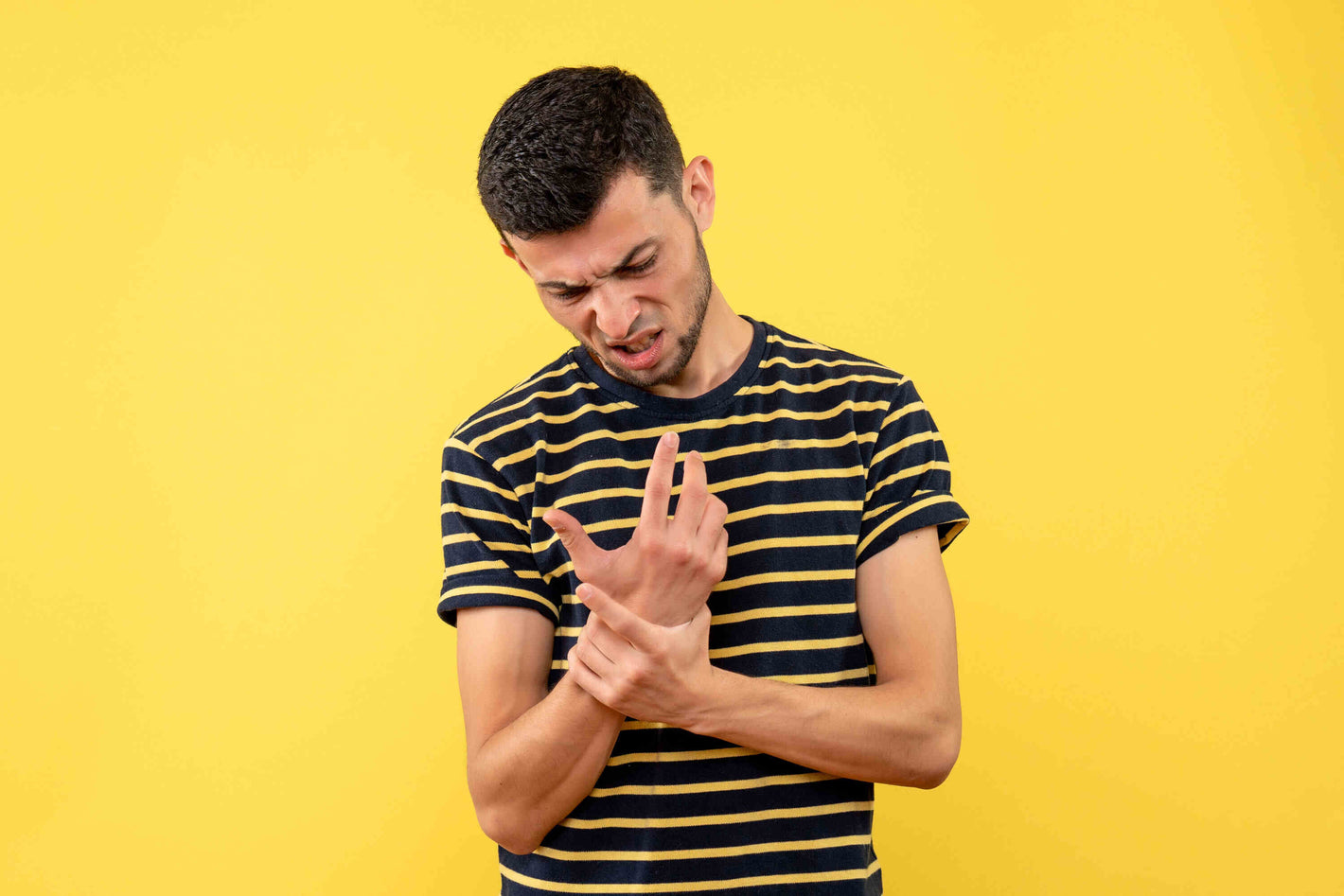How to Identify and Treat a Dislocated Finger?


Finger dislocation is a hand injury which occurs when a bone slips out of its joint. A dislocated thumb or finger is extremely distressing and painful. It occurs at metacarpophalangeal (MCP), interphalangeal (DIP) or interphalangeal (PIP) joints in the fingers.

Accidents, falls, and sports injuries are the major causes of thumb and finger dislocation. Various treatment options are available for dislocated fingers. However, it is not a life-threatening situation, but it is still necessary to seek medical care. This article describes how to identify a dislocated finger and the options to treat it. Continue reading for more details.
There are two joints in the thumb and three in the fingers, and at the joints, the ends of different bones meet. Ligaments are the bands of fibrous material that support the joint and hold various bones together. The dislocation occurs when a severely disturbing force causes the bones to slip out of the joint.
The most important causes of this event are sports injuries, and a 2020 review published in BMC Musculoskeletal Disorders noted that nearly half of the sports injuries, in fact, affect the joints. The sports that are mostly associated with finger injuries are wrestling, lacrosse, basketball, gymnastics, and football. Other factors that cause finger injuries include:
People with health conditions, such as osteoporosis and osteoarthritis that weaken the ligaments and joints are at a higher risk of bone dislocation than others. Crepitus & clicking joints are the other related conditions that sometimes cause joint dislocation. Visit us to know more.
A dislocated finger is crooked and swollen and is extremely painful. The other symptoms associated with dislocated fingers are;
People who have or are suspicious of dislocated fingers must consult the doctor for immediate treatment. While going to the clinic or waiting in line, it is necessary not to move the damaged thumb or finger. The other necessities are;
Finally, allow proper rest to the hand for quick healing. Check our Gopo Joint Health Capsules for healthy and strong joints. Our orthopaedics recommends it for joint health.
The doctors/ orthopaedic surgeons dealing with this cause are interested in knowing when and how the injury happened. The doctors then recommend an imaging test, e.g., MRI and X-rays, to confirm the cause and evaluate the extent of damage to the thumb or finger. The imaging tests for this purpose are;
This scan uses strong radio waves and magnetic fields to develop detailed images of the tissues in the body. The MRI scan is also recommended if significant damage to the surrounding tissues near the dislocated finger is suspected.

These rays use electromagnetic radiation to create an image of the internal structures of the body. The doctors then use these images to check breaks and fractures and confirm the dislocations.
Visit us to read details of health tests, its types and benefits.
Numerous treatment options are available for dislocated joints and fingers and the choice depends upon the severity of the dislocation and location of the joints.
The first step in treating a dislocated finger is to manipulate the affected bone back to its original space carefully. This process is known as Manual reduction. Before this process, doctors often use local anaesthetics to number the target areas in the hands. After complete reduction, healthcare professionals often order an X-ray analysis to check the correct alignment of the bones in the dislocated fingers.
After successfully reducing the dislocated finger, it is advised to wear the splint to immobilise and protect the injured finger during healing. The splint has rigid metabolic strips that support the dislocated or broken bone. The immobilisation protects the bone, stops excessive bone movement, and reduces the risk of more dislocations or injuries.

The orthopaedic doctors often recommend buddy taping of the splintered finger to the nearby fingers. Buddy taping offers better support for the injured fingers and allows greater mobility. Wearing the splint for several weeks is recommended for the person having dislocated fingers. However, it is necessary to avoid excessive wearing or splinting for a very long time as it causes reduced mobility and permanent stiffness.
Sometimes, the dislocated finger involves broken bones, fractures or torn ligaments that need surgical correction through open reduction. Like the other treatments, the purpose of surgical correction is to stabilise and reduce the bones and restore mobility in the finger without damaging the nearby tissues.
This procedure is performed by the orthopaedic surgeon under local or generalised anaesthesia.
Depending upon the severity and type of the injuries, many people with dislocated fingers also experience bone fractures. During a fracture, a significant amount of force impacts the bone and causes it to break or splinter into two or more pieces.
Finger fractures need splinting after reduction, and many people with finger fractures need fixation through K-wire. K-wires are the thin metallic rods that the surgeons implant into the bones to stabilise the bone fragments.
Most dislocated fingers heal completely in just 4-6 weeks. The factors that influence the recovery time are:
After reduction and splinting, many people require occupational and physical therapy.

Occupational or physical therapy teaches a person the necessary exercises to improve the motility and strength of the muscles. The best remedies to try at home include:
After recovery, a dislocated finger is nevertheless more prone to injuries in the future. To reduce the risk of fractures, perform finger and hand exercises to strengthen the ligaments, tendons, and muscles, wear buddy tape or splints during sports activities, and avoid wearing rings during sports activities.
Dislocation in the finger is often very obvious. The target finger appears painful, swollen and crooked. It is often bent at strange angles, and a person is unable to straighten or bend it easily.
Some people just put a splint or plastic cast on the injured area to facilitate healing. Compression bandages are also valuable for reducing swelling. Most of these injuries heal naturally with time. In more severe cases, an appointment with the doctor and follow-up are necessary.
Ignoring the dislocated finger causes damage to the blood vessels or nerves. The blood vessels and nerves close to the dislocated finger are often damaged. Improper healing results due to negligence that results in permanent damage to the finger and loss of mobility.
No, it is necessary to avoid popping the finger back to its normal place. Doing so increases the risk of damage and improper healing. Instead, consult the doctor for proper fixation and alignment.
The fastest treatment options for a fractured, twisted, or dislocated hand are anti-inflammatory medications for pain, splints or casts to keep the finger in place during healing, reducing activity levels to allow proper rest to the areas, and physical therapy to stretch and strengthen the area around the dislocated finger.
The finger has three distinct joints which are supported by collateral ligaments—these are metacarpophalangeal (MCP), interphalangeal (DIP) and interphalangeal (PIP) joints. During jamming, one of the ligaments is partially torn or sprained. The joint becomes completely dislocated if the ligament is torn completely.

Although a dislocated finger is very distressing and painful, it is not life-threatening and needs immediate medical care. It is necessary to avoid dislocating the joint to the normal position, as these manipulations cause more damage to the surrounding structures and joints.
After the successful medical and surgical treatment, allow the dislocated finger a few weeks to heal completely. Damage to the surrounding structures and bone fragments increases the healing time significantly. In case of issues with joint health, kinetic lifting techniques are useful to consider. Read our article to know about Kinetic Lifting and various useful techniques.










Plus get the inside scoop on our latest content and updates in our monthly newsletter.